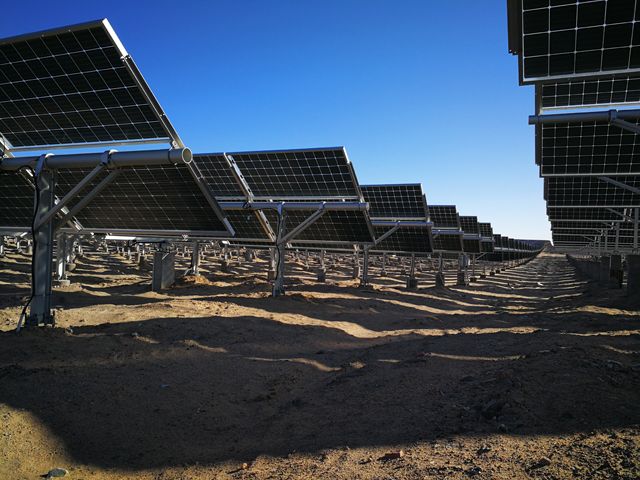
The world´s largest bifacial solar project was connected as part of a 100 MW installation end of 2017 in Golmud in China´s western province of Qinghai. The project, which was developed by State Power Investment Corporation’s Huanghe Hydropower Development Co. Ltd., includes 20 MW bifacial modules from LONGi Solar. In total 71 MW of bifacial module capacity was installed.
“We are very pleased LONGi Solar´s monocrystalline PERC technology will contribute to the success of the world´s largest bifacial power plant,” said Li Wenxue, President of LONGi Solar. Adding, “While this is our first multi-megawatt bifacial project, we are discussing with several developers about further PV bifacial projects using our mono PERC modules in China as well as international markets.” LONGi Solar, the leading vertically-integrated manufacturer of monocrystalline PV modules, has supplied over 57,000 of its 350 W HiMO2 PERC bifacial modules equal to 20 MW for the Golmund project.
PERC for Bifacial
High-efficiency PERC has this year become the standard in monocrystalline cell manufacturing. According to the International Technology Roadmap for Photovoltaic (ITRPV) 2017, monocrystalline wafers will reach a market share of over 40%in 2019 – and most of the monocrystalline modules will be based on PERC cell technology. End of October 2017, LONGi Group, the world´s largest producer of monocrystalline wafers, announced a world record efficiency of 22.71% for a 156 x 156 mm commercial-size cell, which was certified by well-known German research institute´s Fraunhofer ISE´s CalLab and breaks the earlier record that was held by Trina Solar around for 2 years.
No Additional Costs for Bifacial
Bifacial solar, which is about making a PV device sunlight sensitive on both sides, is a natural progression for PERC in pursuit of higher power yields. The good thing about PERC bifacial cells: the energy boost is a free bonus. The only change required is to replace printing aluminum paste over the full area of the rear side through a grid pattern -similar to the front side – again using aluminum paste, and corresponding optimization. At the module level, the opaque backsheet is replaced with glass, which not only provides transparency needed for bifacial power production but also improves module endurance and extends lifetime, a feature solar power plant developers very much appreciate.
Higher Yield for Bifacial
Above all, developers and power plant operators are mostly attracted by bifacial technology´s because of its power output gain at the system level. Depending on the reflection capabilities of the ground on which a bifacial system is installed (so called albedo), it can generate a 10 to 30% higher yield than a traditional monofacial solar system. Bifacial PV systems that have been installed during 2017 in China with monocrystalline PERC cells from LONGI Solar have shown in the first 3 months of testing already at least an 11.27% higher average energy yield than the monofacial systems.
The initial test results of LONGi Solar clearly indicate that opting for PERC bifacial technology is a simple way to improve system yield by a 2-digit amount and thus reduce costs of solar energy generation. The higher the efficiency of the PERC technology used, the better will be the yield – LONGI´s new world record monocrystalline PERC cell shows the way to go, also for bifacial technology. The first developers are already relying on bifacial technology to profit from its benefits – and the Golmund system of Huanghe Hydropower is just the beginning.